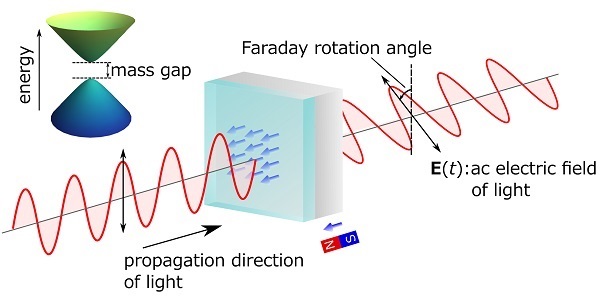2016/09/13
A group of researchers at the University of Tokyo and their collaborators have demonstrated that when a topological insulator—a material that conducts electricity on the surface but not in the interior—with magnetic properties is exposed to light, the angles of the rotation of light polarization driven by the magneto-optical effect show the universal values determined by quantum mechanics.
Magneto-optical effects, which comprise what are known as the Faraday and Kerr effects, refer to general optical phenomena in which the polarization of the light—namely, the direction of ac electric field of light—transmitted through magnetic materials or reflected from them rotates when the magnets are exposed to light. These magneto-optical effects serve as the principle behind optical communication devices and magneto-optical disks. Once topological insulators are embedded with magnetic properties, an energy gap, called a mass gap, is created in surface electrons (see figure), resulting in what is referred to as a quantum anomalous Hall effect—a “quantized Hall effect” that appears in the absence of a magnetic field. The Faraday and Kerr effects occur when the surface of the topological insulator exhibits quantum anomalous Hall effect; scientists had predicted theoretically that the rotation angles of the light polarization would be the universal values determined by quantum mechanics. Since this “quantized magneto-optical effect” exhibits a huge polarization-rotation efficiency in the absence of magnetic field without losing any energy, its observation had been anticipated.
The research group led by graduate student Ken Okada, Project Associate Professor Youtarou Takahashi, and Professor Yoshinori Tokura of the Graduate School of Engineering at the University of Tokyo, and their collaborators stabilized quantum anomalous Hall effect at a much higher temperature (around minus 270 degrees Celsius) than what had previously been attained, by developing a special technique for fabricating the topological insulator. The researchers then irradiated the topological insulator with terahertz light, a type of light that has about one-five hundredth the energy of visible light, which we can feel with our eyes. As expected through the theoretical prediction, they found that at low temperature in which the quantum anomalous Hall effect is well developed, the value determined solely from the Faraday and Kerr rotation angles converges to a physical constant, fine structure constant (~ 1/137) .
In the current study the scientists observed a polarization rotation of 0.15 degree with an 8 nanometer-thick film, which translates into a rotation angle of 200,000 degrees per centimeter. This value is nearly two orders of magnitude as large as that of conventional polarization rotation devices. Since the quantum anomalous Hall effect produces high polarization rotation efficiency without any energy loss in the absence of magnetic field, this phenomenon may lead to energy-saving, high-efficiency optical devices in the terahertz range in the future.
“We were really excited when we observed the polarization rotations of terahertz light, as predicted in theory, in the lab,” says Takahashi. He continues, “The research on topological insulators, as a new group of material in condensed matter, is developing rapidly, and we expect a lot more discoveries of new quantum phenomena in the future.”
The University of Tokyo scientists involved in this research concurrently hold posts at the Center for Emergent Matter Science (CEMS) at RIKEN: Okada is junior research associate in the Strong Correlation Quantum Transport Research Team; Takahashi is unit leader of the Emergent Spectroscopy Research Unit; and Tokura serves as director of the center.
Press release (Japanese)
Paper
K. N. Okada, Y. Takahashi, M. Mogi, R. Yoshimi, A. Tsukazaki, K. S. Takahashi, N. Ogawa, M. Kawasaki, and Y. Tokura, "Terahertz spectroscopy on Faraday and Kerr rotations in a quantum anomalous Hall state", Nature Communications Online Edition: 2016/07/20 (Japan time), doi: 10.1038/ncomms12245.
Article link (Publication)















